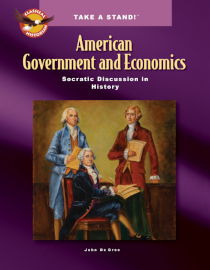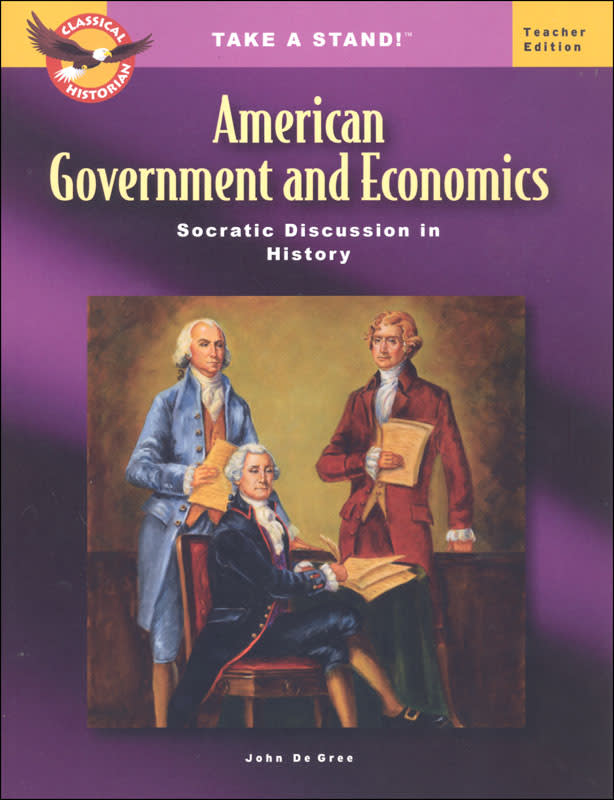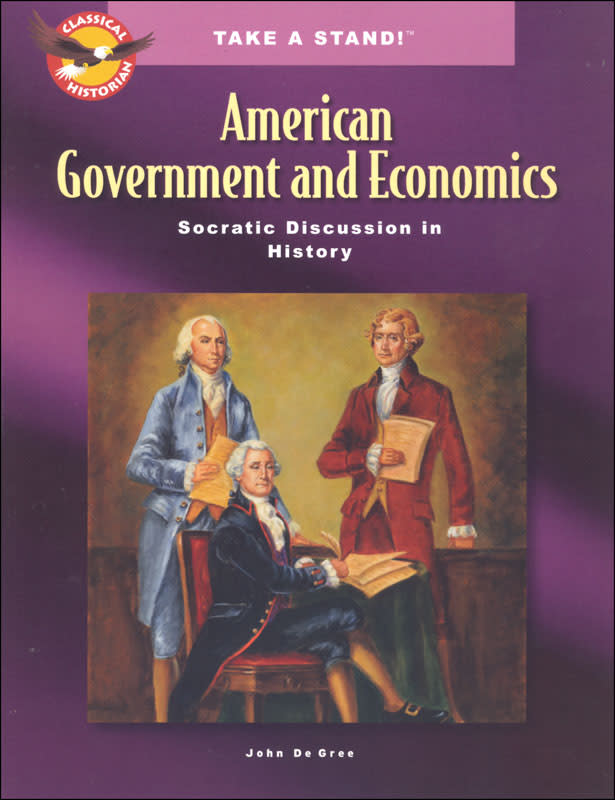The Classical Historian publishes a series of history courses for middle school through high school. The Classical Historian's American Government and Economics course is a one-year, high-school course that will meet the requirements most states have for both government and economics. Since this course covers subject areas other than history, I’ve created this separate review page.
It is possible to use the course with a single student, but it will probably be much more effective if students can participate in a weekly group-class session. The course should require at least one, one-hour class meeting plus up to two hours of homework per week. The time required for a group class will depend very much on the number of students since they will do individual presentations.
The course requires:
- Take a Stand: American Government and Economics: Teacher Edition by John De Gree
- Take a Stand: American Government and Economics: Student Book by John De Gree
- Teaching the Socratic Discussion in History DVD Curriculum (also available via streaming at no extra cost to members of the Classical Historian’s Dolphin Society)
- Basic American Government by Clarence Carson (Not sold by The Classical Historian)
- Lessons for the Young Economist by Robert P. Murphy (Not sold by The Classical Historian)
Primary Source Documents from www.classicalhistorian.com (free)
Parents or teachers leading this course need to first watch Teaching the Socratic Discussion in History to learn how to lead the conversations. If they are already familiar with the Socratic methodology, this can be skipped. For parents who prefer not to teach the course themselves, a live course is available through The Classical Historian Online Academy.
Throughout the course's 32 lessons, students will read, discuss, research, and write. They will also make at least two presentations. The entire course requires the application of critical thinking. The first two lessons lay some groundwork as students work on differentiating facts and opinions, evaluating facts and opinions, and working with primary and secondary sources. On page viii in the teacher edition, it says, "The teacher’s role is not to tell the student what to think, but rather question and challenge the student’s conclusions, forcing the student to continually clarify and defend with historical evidence and sound judgment." So in this course, students will write and make presentations, stating and defending their own conclusions.
Each week, students will participate in Socratic discussions and sometimes write essays on topics such as:
- Is the United States of America in a political crisis or is it not?
- Based on your research of the U.S. Constitution and other evidence, which branch of the American government is the strongest?
- What are the two most important rights in the Declaration of Independence?
- Based on your historical analysis of history, was the U.S. Constitution founded on a premise or premises that you consider false or true?
Similarly phrased questions are posed about the electoral college, western political thought, Andrew Jackson's presidency, the role of the Supreme Court, the powers and size of the federal government, the gold standard, the federal corporate income tax rate, minimum wage laws, a universal basic income, the value of a college education (in relation to its cost), socialism, communism, fascism, government prohibition of drugs, government-run health care, and a few other topics. (Economics topics are not separated from government topics, since they are often tightly related.) You can see that these are important topics, and many of them are of immediate interest in current events.
Some of the topics sound broad, but most lessons have reading material, questions, and prewriting activities that help students grasp the importance of the question and the primary arguments. Parents and teachers might inject additional information if they want to include or advocate another point of view or other ideas besides those likely to come up in the directed student research. Students are encouraged to try to make the case for the position opposite theirs which requires deeper research and more thorough knowledge of a topic.
Even though students consider contrasting viewpoints, use primary source documents such as the Federalist Papers and Franklin D. Roosevelt's "First Inaugural Address," and read balanced information from websites such as ProCon.org, the course as a whole is slanted toward a free market (Austrian economics) and limited-government point of view. This is largely because those are the views of the authors of the two textbooks as well as some of the supplemental videos from PragerU. It is important to point out that the course includes a lesson about identifying media bias, assigning students to read articles on the same politically related topic from different newspapers, then compare them for objectivity and any viewpoints expressed. This is the type of learning that lasts a lifetime!
Once the parent or teacher has become familiar with this method of teaching and learning, he or she might want to add or change topics within this course and should be able to easily do so.
Summary
The integration of government and economics in this course makes both subjects much more interesting. And the course design which challenges students to form and defend their opinions is outstanding. Those who like classical education methods should find this a perfect fit, and those new to classical methods of learning might discover how well they can work.











